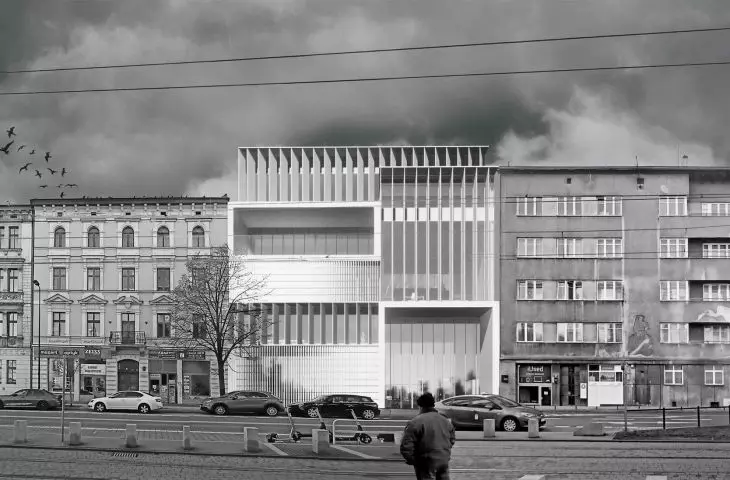Work submitted for the competition
"Best Diploma Architecture"
The subject of the work is the object of the Fashion and Design Center, which is a public building with an exhibition and educational function related to fashion and design. This project is an attempt to answer the question of how to shape new elevations in historical frontages.
relationship with neighboring buildings
© Izabella Janusz
location and land development
It was designed on Pawia Street in Krakow, in a frontage development, among the historic fabric of the city. The object, created as a result of analysis, develops and enhances the characteristic spatial features of the place where it is located, i.e. the historic center of Krakow. It is a space that particularly serves the students of the Krakow Academy of Fine Arts, whose headquarters are located nearby.
There is a current Local Development Plan for the area, which indicated the obligatory building line. The shape of the development was also influenced by a shading analysis, as a result of which the northwest corner of the plot remained undeveloped.
analysis
© Izabella Janusz
function
The building is envisaged for the organization of activities related to fashion and design. A lecture for ninety-five people can be held in the auditorium. It is also possible to organize a fashion show in the multipurpose room. In addition, there are open spaces for work and study, among others. A store is provided on the first floor, where products created at workshops, for example, will be sold.
axonometry and functional diagram
© Izabella Janusz
The building is designed according to the principle of universal design. It is designed for users of any age or social group. This includes adaptation to the needs of people with disabilities (adapted elevators and toilets on each floor, additional seats in the auditorium).
3D cross-section
© Izabella Janusz
main architectural idea
The main idea of the project was to shape a building with a facade that fits well into the context of its historical surroundings, which at the same time, thanks to its appearance and the technologies used, will be a showcase of the 21st century.
The facade of the designed building is made entirely of glass, which allows one hundred percent light transmission. It allows connecting outdoor and indoor space without a visible barrier. In front of the glass partition, panels were designed that can manipulate the access of light to the interior. The designed facade was shaped from three types of surfaces: one including only the aforementioned glazing, and two containing glazing and an additional obscuring partition.
scheme of ecological solutions
© Izabella Janusz
The first type of surface is fully transparent glazing, allowing the greatest amount of light into the interiors. They have been used in places that require absolute connection, both visually and communicatively, i.e. street — main hall, foyer — terrace. The transparency of the glass makes it possible to separate individual rooms inside the building without creating a barrier between them, and its use on the first floor invites passersby into the building.
The second type of surface is parametrically designed partitions. The result is small vertical tiles permanently fixed to the glazing. Through different angles of placement, they create a gradient directly related to the function inside the building. This type of surface allows providing the interior with the right amount of daylight, which, piercing through this form, creates interesting images in the interior.
algorithm for shaping a parametric facade
© Izabella Janusz
The last type is large kinetic panels, opening and closing according to the needs of the users of each room.
construction
The building is made entirely of reinforced concrete technology, and due to its location in the downtown frontage, it was necessary to protect the excavation. For this purpose, a palisade was designed, and then waterproof concrete technology was used.
The front facade is structural glazing obscured by two types of panels. One is kinetic panels, opening and closing according to the users' needs. The other type of aperture is fine ceramic tiles designed parametrically.
visualization
© Izabella Janusz
ecological solutions
The building uses environmentally friendly solutions, including an air-source heat pump that provides heating and hot water in the building, photovoltaic panels, a rainwater retention tank (excess water is discharged into the city's rainwater drainage system) and kinetic panels to protect against overheating.
Izabella JANUSZ
Illustrations: © Author























































